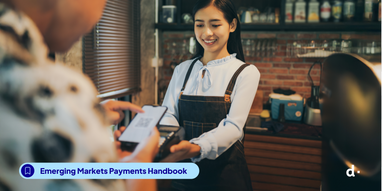Asia’s payment powerhouse: Countless ways to pay, one digital future

From RTPs to eWallet-driven ecosystems, Asia’s payment story is as diverse as its markets, and it’s rewriting the future of eCommerce.
Quick summary
- Home to 4.8B+ people, Asia isn’t just the world’s largest market, it’s also one of its youngest and most mobile-first.
- A fast-growing middle class is fueling eCommerce surges from India’s tier-two cities to Indonesia’s island provinces.
- South Asia is rewriting the payment rulebook with real-time rails like UPI and Raast processing billions of transactions a month.
- In Southeast Asia, wallet-driven ecosystems thrive, backed by national QR standards such as QRIS in Indonesia and VietQR in Vietnam.
- A few trends are shaping the future: instant payments becoming everyday behavior, eWallets & SupperApps evolving into financial hubs, BNPL opening up higher-value purchases, and the first steps toward cross-border payment interoperability.
- This blog continues our series based on dLocal’s Emerging Markets Payments Handbook 2025.
Asia’s payment powerhouse
Asia is the largest and most diverse emerging market region in the world, home to over 4.8 billion people, fast-growing economies, and some of the most advanced payment systems anywhere. Yet there’s no single Asian payment story. From India’s real-time rail dominance to Southeast Asia’s SuperApp ecosystems, each market is writing its own chapter in the continent’s payment revolution.
For global merchants, the opportunity is immense, but it comes with a clear rule: growth depends on understanding how each market pays, not just that it pays digitally.
The power of people: Demographics that move markets
The payment transformation in Asia begins with its people. The region is home to some of the youngest populations in the world, with a median age of just 21 in South Asia and under 31 in much of Southeast Asia. Smartphone adoption is widespread: in Indonesia and Vietnam, penetration is above 75%, while in India, hundreds of millions of users have skipped the desktop era entirely and gone straight to mobile.
The middle class is expanding at a record pace. In emerging Asia, millions of new consumers join the digital economy each year, bringing higher incomes and greater expectations for speed, convenience, and choice at checkout. Digital commerce is growing by double digits in most markets, with growth drivers ranging from the rise of regional eCommerce platforms to expanding cross-border trade, accelerating industry digitalisation, and stronger participation from global brands.
Same continent, different realities
One of the biggest mistakes global businesses make is treating Asia as a single market. The differences between its subregions are stark, from payment infrastructure to consumer trust, regulation, and merchant readiness.
South Asia is where bank transfers and real-time rails are rapidly replacing cash. In India, the Unified Payments Interface (UPI) processes over 10 billion transactions a month and accounts for more than 55% of all eCommerce payments. Its reach now extends deep into tier-two and tier-three cities, bringing millions of new consumers into the digital world.
Pakistan’s Raast is following a similar trajectory, enabling instant transfers between banks, wallets, and merchants using an alias. With less than 10% of adults holding a card, bank transfers and eWallets like Easypaisa and JazzCash are bridging the financial inclusion gap.
In Southeast Asia, the model relies heavily on eWallet ecosystems. In Vietnam, SuperApps like MoMo dominate daily financial life, offering payments alongside bill pay, entertainment, and travel bookings. In Indonesia, the QRIS standard has unified QR code payments across millions of merchants, from roadside vendors to major online marketplaces, with more than 55M users.
“In Indonesia, we’re seeing digital payments become second nature, and that shift is opening doors for businesses ready to meet consumers where they are.” Jessica Goh, Operations (APAC) at dLocal
Four trends transforming Asia’s payments
1. Real-time payments going mainstream: UPI in India, Raast in Pakistan, BI-FAST in Indonesia — instant rails are moving money in seconds. In India, over 55% of eCommerce transactions now use UPI. In Indonesia, BI-FAST has processed more than 1 billion transactions since its launch.
2. SuperApps evolving into financial hubs: GCash in the Philippines, OVO in Indonesia, MoMo in Vietnam — these platforms handle everything from payments to savings, microloans, and insurance. In the Philippines, over 80M people now have a GCash account, showing what’s possible when platforms integrate into daily life.
3. BNPL making big-ticket purchases more accessible: In markets with low credit card use, like Pakistan, Indonesia, and the Philippines, Buy Now, Pay Later (BNPL) is helping consumers afford bigger purchases. In Indonesia, it’s used for 17% of online travel bookings, while wallet partnerships are driving growth in Malaysia and Vietnam. In India, BNPL is projected to surge to a multi-billion-dollar market.
4. Cross-border interoperability experiments taking shape: From UPI’s ties to neighbouring real-time rails to ASEAN’s QR code standardization plans, Asia is testing cross-border acceptance that could make regional eCommerce far more seamless.

Country spotlights
Asia’s payment story is deeply local. Each market is shaped by its population profile, digital adoption stage, and payment infrastructure. Here’s a look at some countries that capture the continent’s diversity and momentum.
India
A young, mobile-first population and widespread smartphone access are powering one of the world’s fastest-growing digital economies. UPI processes the bulk of retail digital payments and reaches deep into tier-two/three cities.
Pakistan
Large and youthful, with one of the lowest card penetration rates in Asia. Digital adoption is accelerating through government initiatives and real-time payment infrastructure, positioning the market for significant gains in financial inclusion.
Indonesia
A vast archipelago with a rising middle class and strong urban demand. Digital infrastructure improvements are creating more consistent retail experiences across islands, supporting the country’s projected role as a top-five global economy by 2045.
Vietnam
A 100 million–strong economy with high digital engagement and rapid GDP growth. Government-backed initiatives are improving interoperability between banks and fintechs, creating fertile ground for broader eCommerce and cross-border activity.
Philippines
Young demographics, heavy mobile usage, and major remittance flows shape behavior. Wallets are embedded in everyday life with rising QR acceptance and improving rails supporting broader digital participation.
Malaysia
A connected, high-income market with near-universal banking access. Continued innovation in digital services and cross-border initiatives is reinforcing its role as a regional hub for trade and payments.
Thailand
An urban, digitally savvy population with high smartphone adoption and a mature SME base. A mature real-time payment ecosystem has set the stage for greater digitization in business-to-consumer and government-to-citizen transactions.
What it means for global businesses
The payments landscape in Asia is diverse by design, shaped by regulatory frameworks, consumer preferences, and the maturity of local infrastructure. This makes the region a high-reward, high-complexity environment for global merchants.
- Payment maturity varies and directly influences checkout strategy
In India, UPI dominates and powers the majority of retail digital payments. In contrast, cash-on-delivery still accounts for over 30% of eCommerce orders in some Southeast Asian markets. A single global checkout template risks excluding high-intent buyers if it does not align with local adoption curves.
- Regulation is active and can change the economics
Rules around data, licensing, and processing can influence how transactions are handled and where they’re settled. Staying aware of these factors helps maintain operational efficiency.
- Cross-border readiness is still developing
While initiatives like UPI linkage with other payment methods are promising, true interoperability across Asia is still in its early stages.
- APM diversity can influence average order value (AOV)
In markets with low credit card penetration, BNPL and wallet-based credit options are opening access to higher-value purchases, particularly in retail and travel. Businesses that add these payment methods can expand cart size and reduce drop-offs for high-ticket items.
- Remittance-driven economies create unique flows
In remittance-heavy economies, like the Philippines, funds often flow directly into digital wallets, creating spending peaks that merchants can tap into.
- Mobile-first means design-first for payments
In India, more than 80% of eCommerce transactions happen on mobile devices. Payment flows must be optimized for small screens, fast load times, and minimal redirects to avoid abandonment.
Treating Asia not as a single expansion region but as a portfolio of interconnected and highly distinct payment markets positions global businesses to win repeat customers and sustain growth.
Key takeaways
- Asia is a collection of very different payment markets: growth comes from understanding each one on its own terms.
- South Asia is leaning heavily into instant bank transfers, while Southeast Asia runs on wallets and national QR systems.
- BNPL is filling the credit gap in many markets, making bigger purchases more attainable.
- Early cross-border payment links are emerging, with the potential to make regional commerce much more connected.
- Those ready to localize their payment mix, adapt to shifting regulations, and tap into digital-first habits will find some of the fastest growth potential anywhere in the world.
What’s next in this series
Our upcoming blogs break down payments, exploring other regions in detail: from Africa’s mobile money dominance to the Middle East’s unique consumer preferences, and LATAM’s blend of cards and alternative payments. We’ll also examine the APMs transforming these markets, sharing practical strategies drawn from dLocal’s Emerging Markets Payments Handbook 2025.
Get in touch with our payment experts
We help global companies such as Amazon, Spotify, and Microsoft find new opportunities in high-growth markets. Let's think outside the box for tailor-made payment solutions for your business. Fill out this form, and we'll get back to you as soon as possible.
Contact us




